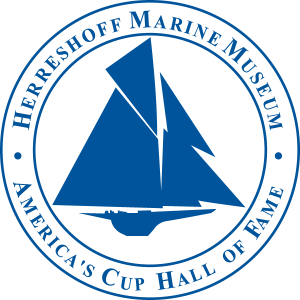
The Herreshoff Legacy Lives On
By John Burnham
By far the most distinctive trophy in the Fishers Island Yacht Club (FIYC) for the last 55 years is a scale model of a 15-and-a-half foot Bullseye in a glass case. Awarded to the club skipper who finishes first in the summer series each season, the trophy is named for its former owner, H. Lee Ferguson, and houses a model of Ferguson’s boat, Peregrine. Known as Lee, Ferguson died in 1965 at age 50, and the trophy was donated in his memory by fellow sailor, Reynolds duPont.
On any July or August Saturday in 2021, a fleet of six to ten Nat Herreshoff-designed Bullseyes can be seen sailing outside the island’s West Harbor, vying to win that trophy. And the full-size version of Peregrine is typically sailing near the front, close alongside Shamrock, duPont’s boat now sailed by his son, Tom. In the cockpit of Peregrine are Heather Lee Ferguson Burnham and her husband David C. Burnham II.
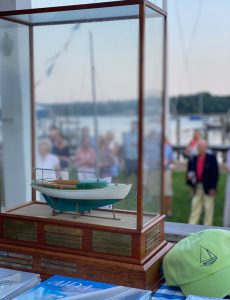
A scale model of the Bullseye Peregrine, the H. Lee Ferguson Trophy is the most distinctive trophy at Fishers Island Yacht Club. Courtesy of the Herreshoff Marine Museum
(Note to readers: We would ordinarily dispense with middle names and initials, etc., but in writing about multi-generational sailing activity, it helps to keep track of who is who.)
To those of us who grew up racing small sailboats on Fishers Island, NY, a skinny island that stretches along the Connecticut shoreline just south of Groton, Mystic and Stonington, the Ferguson Trophy represents generations of our sailing families—Ferguson, duPont, Burnham, Glendon, Parsons, Thompson, Porter and others who have competed for bragging rights in the sturdy, comfortable, not-too-fast Bullseye. But we rarely stop to remember that the Bullseye and other Herreshoff designs had already been sailing at Fishers for 30 years when the current fleet of fiberglass models arrived on the island in the late 1950s.
The first Bullseyes to come to Fishers Island were built in Bristol, RI in the 1920s by the Herreshoff Manufacturing Co., which began producing Captain Nat Herreshoff’s seaworthy little design—12 and a half feet on the water line, 15 feet, 8 inches overall— in 1914 as the Buzzards Bay Boys Boat. Among the first to Fishers was Hull No. 1038, ordered in 1926 by Henry L. Ferguson, for his son Lee. These were Heather’s great-grandfather and grandfather, respectively, and as was common at the time, boats were named for the club where they would sail, in this case Fishers Island Bullseyes.
The late ‘20s and the ‘30s were a robust time for sailing at the FIYC, with more than 30 boats sometimes competing in three classes. The connection between the Herreshoffs and Fishers Island grew in the late ‘20s when a few Fishers Island sailors also began purchasing a much larger 1927 Herreshoff design, a 43-foot Sidney Herreshoff[1] design called the “Fishers Island Auxiliary Sloop class,” which would later be known as the Fishers Island 31. This boat was really a cruising boat with accommodations belowdecks and a small forepeak cabin for a paid crewmember, yet they were raced as one-designs for five years. According to Maynard Bray, in a 1980 WoodenBoat magazine article, “In 1932, there was a move to smaller boats without the expense of a paid hand. These were the Fishers Island 23-footers (34’ overall), also a Herreshoff product.”
The Fishers Island 23, which islanders called the Herreshoff or H-23, was a remarkably different boat than the Bullseye and Fishers Island 31. The Bullseye was a Nat Herreshoff design, and the 31 was an adaptation of one of Nat’s designs by his son, Sidney. The 23 was purely Sidney’s design, a slender, easily driven hull with long overhangs and a modest sailplan[2].
As an aside, I’ll add that these strikingly beautiful boats set a standard for what a racing fleet should look like, and I think we can credit Sid Herreshoff for the later acquisition of fleets of sleek Luders-16s and Quincy Adams 17s, followed in the ‘80s by our current “big boat” one-design fleet, the 33-foot International One-Design.
The Fishers Island Registry of 1934 included a List of Yachts, among them five Fishers Island 31s, ten H-23s, and twenty of the ubiquitous Bullseyes. Among the owners were several Fergusons, plus most of the men who would serve as commodore of the FIYC through the early ‘60s—Arthur Whitney, Franklin Haines, T.W. Russell, William Hubbard, John Nicholas Brown, and brothers Pierre and Reynolds duPont.
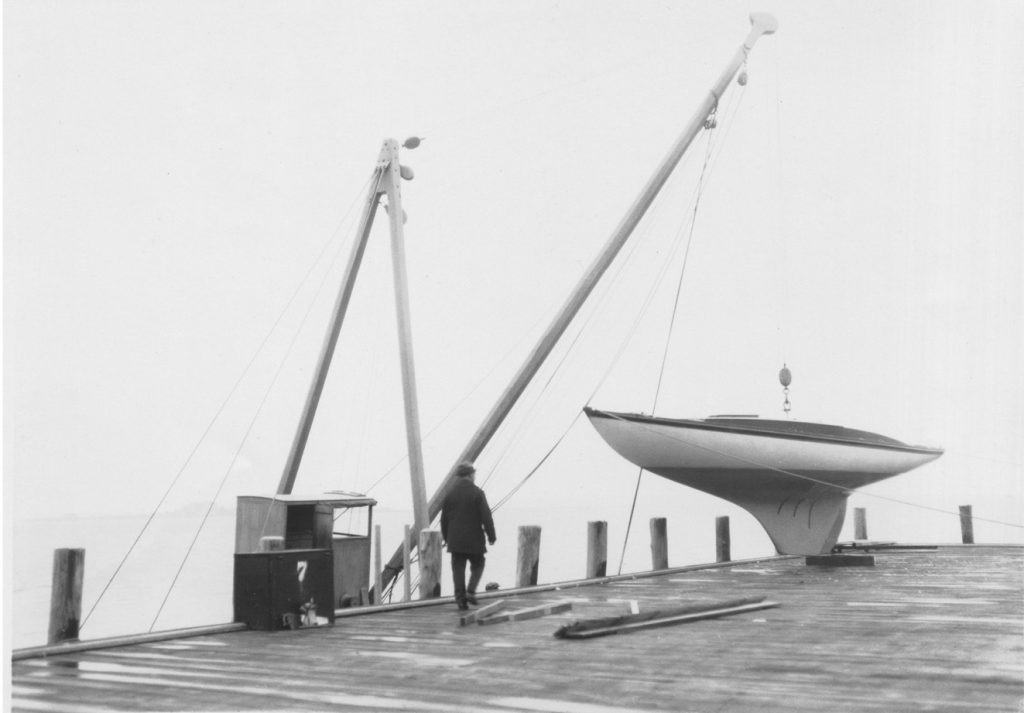
H-23 Tronda prior to launching, 1932 Courtesy of the Herreshoff Marine Museum
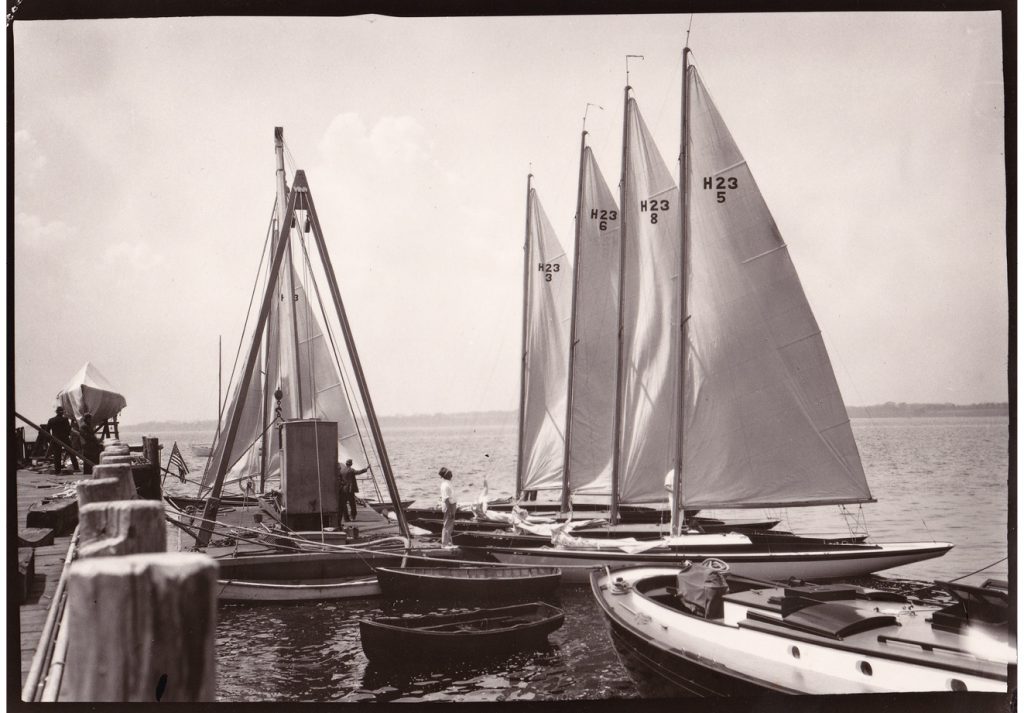
H-23s on the dock at HMCo. ready for delivery Courtesy of the Herreshoff Marine Museum
It’s a little hard to fathom today, but each Saturday’s races back in the ‘30s were reported in papers like the Hartford Courant and The New York Times. Reports included the length of the course, the start time, the order of finish and even the finish time of each boat. Typically, there were results for H-23s, L-16s and the Fishers Island Bullseyes.
From the July 15, 1937 Hartford Courant: “Fishers Island, N.Y., July 14…Reynolds Dupont today sailed “Crenthoza” to victory by 29 seconds over “Chance,” sailed by Gordon Murphy in the H-23 footers class of the regular Wednesday Fishers Island Yacht Club regatta….Howard Ferguson piloted “Home Run” to first place in the L-16 footers class, defeating “Black Duck,” sailed by Charlie Ferguson. Glenn Young captured the Bulls Eye event by 54 seconds over Robert Harvey’s “Buddy….”
The 1938 Hurricane nearly ended the days of Herreshoff boats at Fishers, wrecking many of the Bullseyes and H-23s, but enough of them survived that racing continued both before and after the War.
A turning point came in the ‘50s, however, as club members began purchasing new fiberglass Bullseyes at Cape Cod Shipbuilding, which had bought the license to the Herreshoff Bullseye design when HMCo. ceased operation. Although wooden Bullseyes continued to compete, they were known to soak up a lot of water by mid-season and lose speed to the glass boats. Reynolds duPont’s son Tom remembers crewing aboard one as a youth and finishing far behind.
duPont also recalls racing QA 17s as a teenager in the ‘60s until a fire at Mystic Shipyard destroyed several of the boats. By the time H. Lee Ferguson died, the fiberglass Bullseyes had become the last one-design fleet at FIYC, with adult racing on weekends and juniors racing them on Wednesdays.
duPont, who is the vice commodore of the club, still owns and races his father’s Shamrock more than 50 years later. He says, “Dad got Shamrock when my sister Candy was a teenager. She raced in the Wednesday series and crewed for him on Saturdays. I remember that’s when Harris Parsons and Dad had a colossal wreck and caved in the front quarter of Shamrock.”
John Glendon, immediate past commodore at FIYC, remembers Reynolds duPont and Shamrock from an early age, too. “My mother and I used to go fishing when I was young,” he says with a laugh. “We tied up to the harbor buoy rather than anchor one Saturday and it turned out to be a mark of the course that day. I remember Shamrock rounding the mark and Reynolds duPont yelling at my mother for tying up to the buoy!”
Glendon’s father, Bill, first bought a Bullseye named Sea Witch and began racing it for the 1966 season. They were immediately successful and won the Ferguson Trophy in the first year it was offered. The competition in those years came from Eliot Porter, Harris Parsons, and Lee Ferguson’s brother, Charlie, who’s name appears on the trophy six times from 1970 to 1995.
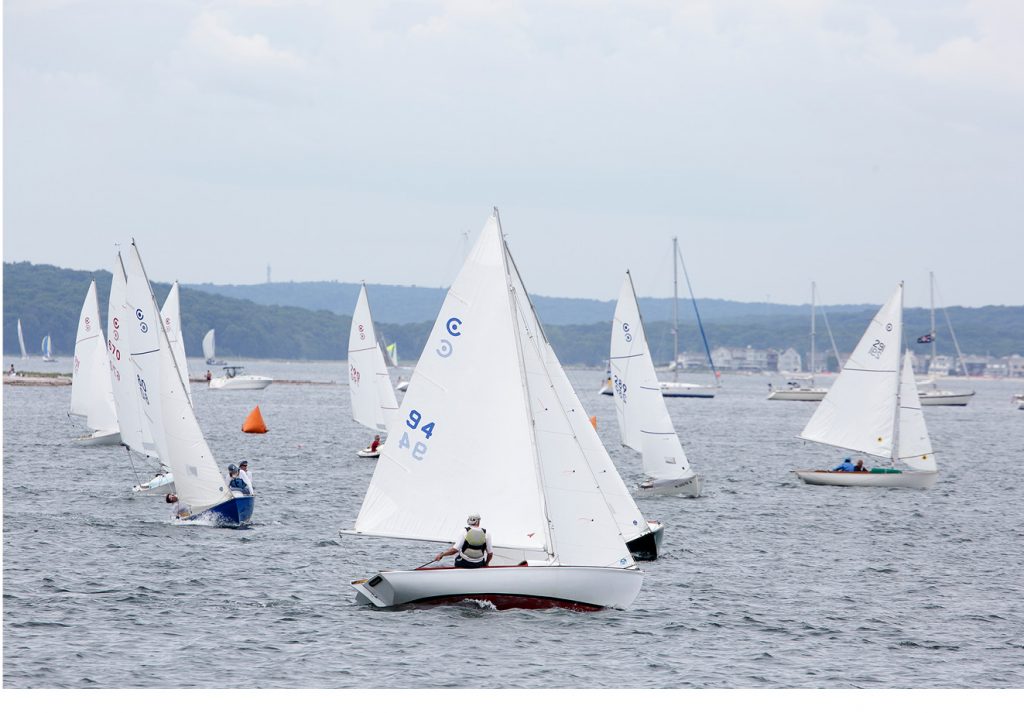
Peter Rugg and Carter Rose sail to a 2014 Nationals victory in Pegasus (94), a Bullseye that has been crossing tacks with Shamrock (green hull) and Querida (blue hull) at Fishers Island for more than 60 years. © Chip Riegel
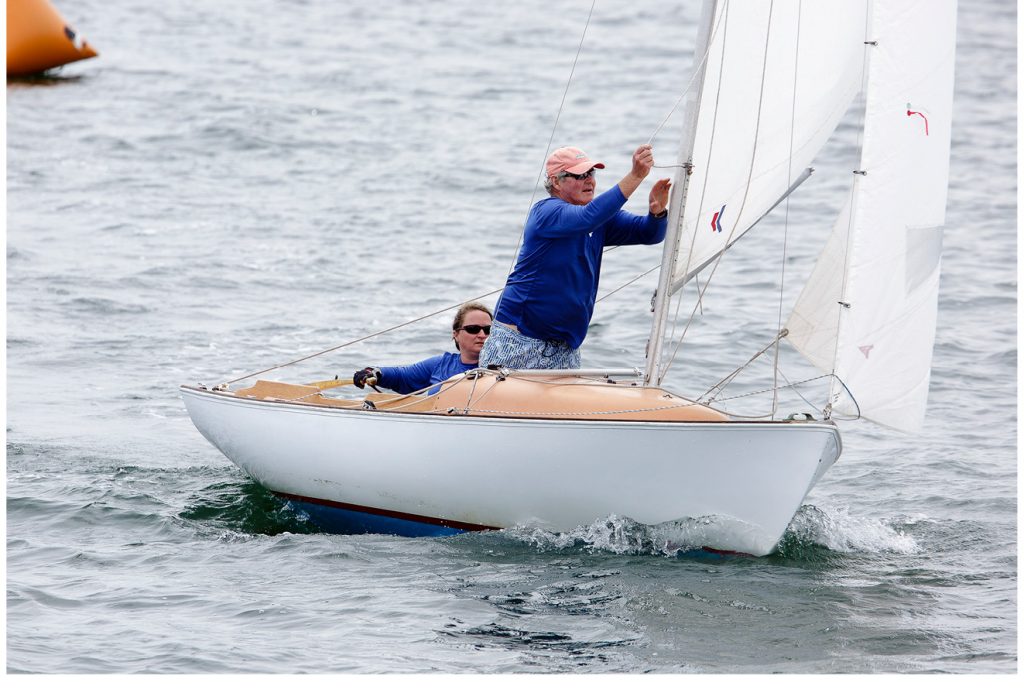
Sailing in 2014, Heather Ferguson Burnham and David C. Burnham II sail Peregrine, the Bullseye that Heather’s grandfather first sailed in 1957 and David’s father later raced for many years. © Chip Riegel
The story of the Herreshoff legacy takes a personal turn for this author about the time John Glendon headed to college. His father, Bill, offered me the same deal his son had enjoyed — crewing for him on the weekends and skippering the boat on Wednesdays. It was a great deal for a 15-year-old who was already hooked on racing Sunfish and any other boat that came along. I recall learning some new curse words during spinnaker sets and jibes, but overall I had three great seasons of in-depth training on wind shifts, tidal currents, tactics and sail trim from the deck of a Bullseye.
Yet the plot is even a little thicker than that as this, after all, is an island community we’re talking about. Bill Glendon was my uncle, married to my mother’s sister (who also took me fishing near the mouth of the harbor). And my dad, David C. Burnham, who had been crewing in Bullseyes and other boats since the ‘40s on Fishers Island, had taught his brother-in-law Bill to sail when my Aunt Susan first brought my Uncle Bill to the island to visit. In a very real sense, I was simply continuing the family sailing lessons I began with my dad at age 6 in a dinghy.
When I started teaching sailing at FIYC in 1974, my dad decided it was finally time to buy a Bullseye. That turned out to be not only another seminal moment in my sailing life, but it also opened a new chapter for connecting Fishers Island Bullseye sailing to Bullseye sailors everywhere.
The boat my parents bought was Little Goodie, which had won the Ferguson Trophy in 1971 with Stowe Phelps at the helm and his son-in-law Peter Rugg as crew. It was still a fast boat, even though it was built in 1955.
My dad rechristened her Querida, the name his father had used for all of his little power and sailboats, and then decided he would sail her up to Buzzards Bay, a two-day trip, to compete in the Bullseye Class National Championship. We were surprised and excited to win that regatta and then do the same in Marblehead, MA, in 1976. The next year, buoyed by Querida’s success, Fishers Island hosted the event, which was the first such sailing championship at Fishers.
David C. Burnham kept competing at the Nationals nearly every year, right through to the 2013 Nationals, the year before he died at age 83. He won the title four times more, but joked that he more often won the “Most Improved” award for finishing badly in one regatta and much better in the next. For him, the adventure was a bigger thrill than the competition anyway. Ideally, that meant sailing to the regatta venue if he could, whether it was Marion, MA, on Buzzards Bay, or Rockport, north of Boston, which was a three-day trip.
Several other Fishers Island sailors travelled with him to the Nationals, although most found a trailer and went by road. Most successful among them was Peter Rugg, winning six times, typically sailing with his daughter Caroline.
National competition is exciting for some, but it’s not what keeps a one-design racing fleet healthy. As at any club, participation has waxed and waned on Saturdays, and some years at Fishers it appeared to be on life support.
When we had a Herreshoff Night at FIYC in mid-July this year to celebrate the legacy of Herreshoff designs and the Golden Jubilee anniversary of the Herreshoff Marine Museum, my nephew David H. Burnham told the assembled guests a story about crewing in Querida one Saturday with his grandfather, David C. Only one other boat, Peregrine, showed up to race, with another uncle of mine, Brad Burnham, at the helm.
“Grandpa, why do we bother to sail against one other boat?” inquired David H.
“Because if we don’t race our Bullseyes today,” answered David C., “there might not be any Bullseye racing tomorrow.”
Today, David H. owns Querida and is treasurer of the Bullseye Class Association. The Nationals, postponed from 2020, are planned for Fishers Island in 2022, and the racing fleet is nearly the size as it was in the ‘30s with nine IODs and ten Bullseyes racing on a recent Saturday. One difference is that the club now owns and offers several Bullseyes to members who don’t own boats.
Speaking at the same Herreshoff event, John Glendon talked about how the Bullseye, a design that’s more than 100 years old, fits so well into the goals of the club to get people back into sailing or at least into boating:
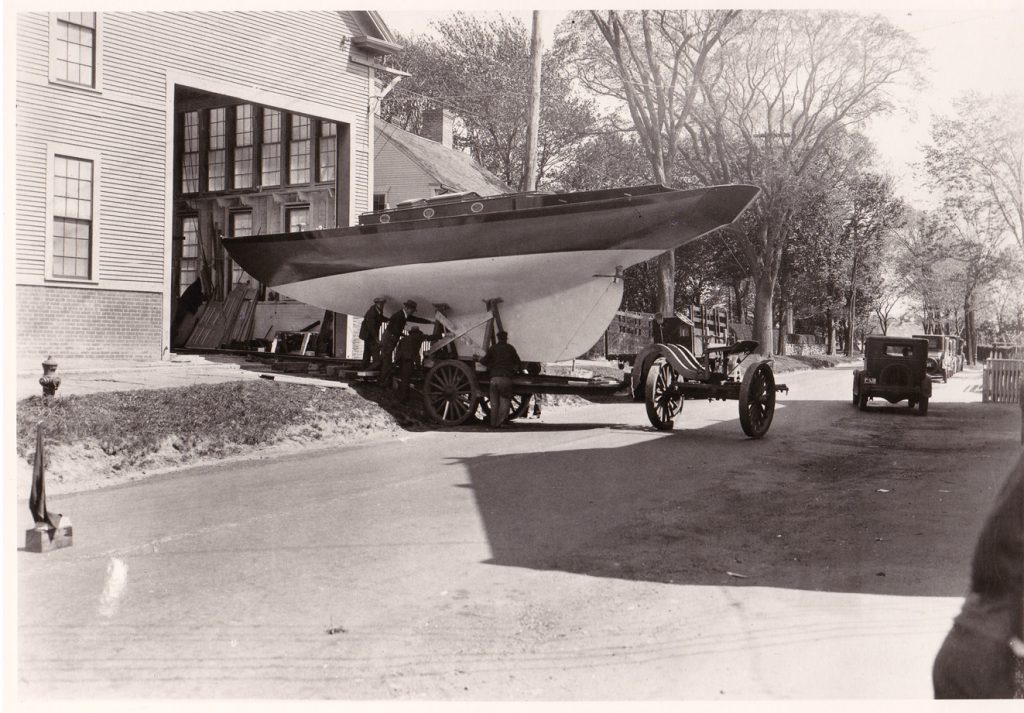
A lovely Fishers Island 31 named Kelpie rolls out of the HMCo. shop. Courtesy of the Herreshoff Marine Museum
“To me it’s the perfect family sailing boat, whether for a parent and child, couples, or two friends. It’s sufficiently comfortable that you don’t bang into each other, and I like that it’s low to the water and you get the sensation of movement. Its range of speed is 0 to 5 knots, so you can really appreciate it when you pick up a little speed.”
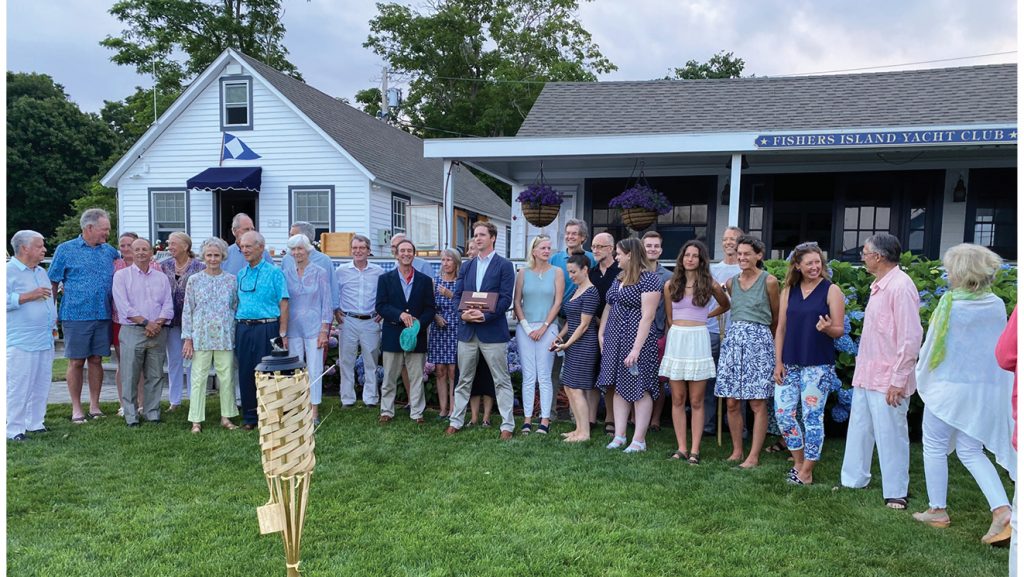
Multi-generational Bullseye sailors enjoy a recent gathering at FIYC. Courtesy of the Herreshoff Marine Museum
For Heather L. Ferguson Burnham and her husband David, Bullseye racing is special because both run businesses on the island and are busiest in the summer, so it’s a good escape. They’ve won a few races too, adding their names to the Ferguson Trophy in 2018 and 2019. But just as important, they’re sailing together on Peregrine, which both of their families have owned and sailed before them. “Saturdays are old school Fishers Island,” Heather says, “a perfect antidote to the rest of the week.” ■
John Burnham grew up sailing at Fishers Island and currently races an International One-Design (IOD) sloop on Saturdays with three friends. As a skipper and crew, sailing with his father, he is a three-time Bullseye national champion and has won class titles in the IOD and Shields classes as well. Currently a leadership coach and freelance editor/writer, Burnham is former editor of Sailing World and Cruising World magazines and the websites boats.com, YachtWorld and BoatTrader.
[1] Sidney DeWolf Herreshoff, or Sid Herreshoff
[2] There is something to this trajectory worth commenting on – pure Nat with the 12 ½, a father-son combination for the 31s (or, son building on previous design of his father’s), then pure Sid for the 23… a nice complement to the multigenerational aspect of the club itself.
